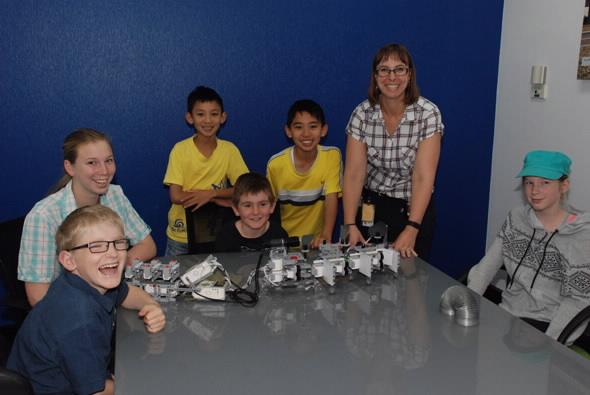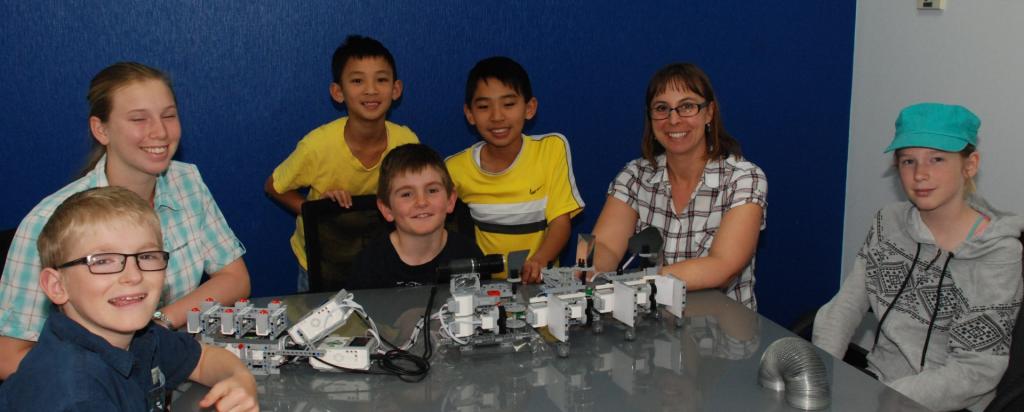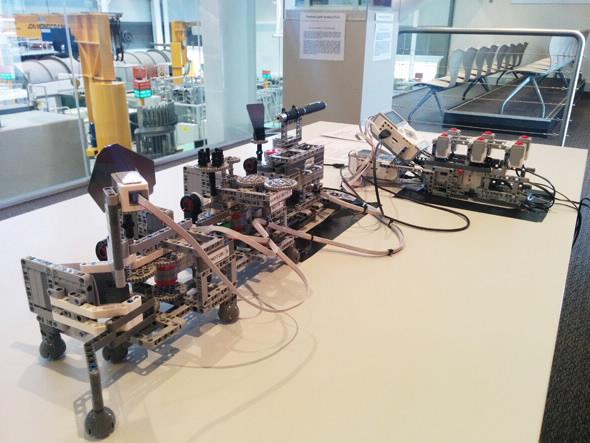

Published on the 19th October 2015 by ANSTO Staff
A new LEGO model of one of ANSTO’s most complex neutron beam instruments—the Taipan triple axis spectrometer, will be on display as an educational resource early next year. Visiting school kids will be able to control the model and gain an understanding of the real thing.
 |
| Instrument scientist Kirrily Rule (second from right) explains how ANSTO's real triple axis spectrometer Taipan works to kids who have an interest in LEGO robotics |
The new replica, which is programmable to move like the instrument, was built by John Burfoot of Macquarie ICT Innovations Centre (MacICT), a collaboration between the NSW Department of Education and Macquarie University, in association with ANSTO researchers and education officers.
Burfoot, a science and robotics facilitator at MacICT, built the model over several weeks using three LEGO®; MINDSTORMS®; EV3 kits.
“About a third of the time went on the design, another third on building it and the final third on the programming,” said Burfoot, who has designed many robots for school education previously but not a scientific instrument until now. He described the experience as exciting, inspiring and a little bit scary.
“It recaptured the flow or synergy you feel during the creative process—something that children who build robotic models can also experience.” When he encountered technical problems, he consulted with student engineers at Macquarie University to find solutions.
Six local school kids whose parents work at ANSTO will construct another Taipan model themselves, add enhancements, make refinements and programme it following a guide developed by Burfoot. The kids, who are aged between 9 and 15, will compete in the First LEGO League, a robotic Lego building competition.
Instrument Scientist, Kirrily Rule, who operates Taipan and collaborated with Burfoot on refinements to the model, is very enthusiastic about the new resource.
”It’s very different than the LEGO I used as a kid. Much more than a toy, education officers can use the model to demonstrate physics to children and hopefully stimulate their interest in science,” said Rule.
Like the original instrument, it has moving parts. “You can control how it moves, just like our Taipan, which bends like a snake,” said Rule.
Configuration changes are made to the instrument to suit the experiment. The three main sections or axes are the monochromator (which selects neutrons of a particular energy), sample (which scatters the neutron beam) and analyser (which analyses the energy of the scattered beam).

One of the striking features is the use of a small glass prism as the sample, which was purchased on the internet. “We are using the prism to split the white light into the colours of the rainbow – which each have different wavelengths (and energies) - to show how the neutron’s energy can change during the interaction with the sample,” said Rule.
“So instead of thermal neutrons in the LEGO model, we are using light. The concept is very similar.”
They also needed a mirror-like material for the model to reflect the light from the prism. “We used offcuts from the silicon panels that came from our Emu instrument, which brings another level of accuracy to the model,” explained Rule.
Taipan is primarily used for neutron inelastic scattering, which measures the collective motion or vibrations between atoms (known as phonons) or magnetic spins (known as magnons). The instrument has been used to provide evidence regarding the mechanisms of high temperature superconductivity.
Rule also stresses that Taipan can also be used for pure elastic scattering of neutrons. “It resolves weak features clearly because you can select very specific energies.”
Rule is helping to develop education resources to be used in association with the LEGO model. “The challenge is to come up with simple explanations of complex concepts in physics, like phonons and inelastic scattering,” she said.
There are plans to create additional LEGO models for all the neutron beam instruments. The next is likely to be Wombat, a high intensity powder diffractometer.
According to education technology expert Dr Damien Kee, robotics encourages kids to think creatively, analyse situations and apply critical thinking and problem solving skills to real world problems.
Other custom LEGO models developed elsewhere include neutron instruments at the Institut Laue-Langevin in France. The ATLAS particle detector at CERN, the Space Shuttle, the James Webb Space Telescope and the Curiosity Rover have also been constructed with LEGO.
ANSTO runs LEGO Education robotics workshops as part of a school holiday program, facilitated by Macquarie ICT Innovations Centre.